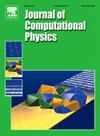Enhanced profile-preserving phase-field model of two-phase flow with surfactant interfacial transport and Marangoni effects
IF 3.8
2区 物理与天体物理
Q2 COMPUTER SCIENCE, INTERDISCIPLINARY APPLICATIONS
引用次数: 0
Abstract
Using a regularized delta function to distribute surfactant interfacial concentration can simplify the computation of the surface gradient operator , enabling the phase-field model to effectively simulate Marangoni flows involving surfactant transport. However, the exact conservation of total surfactant mass is compromised due to deviation from the equilibrium phase field profile, numerical diffusion, and mass non-conservation in each phase. To overcome these limitations, we have developed a new model for simulating two-phase flow with surfactant transport along the interface. This model employs a profile-preserving strategy to maintain the equilibrium interface profile, ensuring accurate calculation of the regularized delta function and improving surfactant mass conservation. Within the framework of the advective Cahn-Hilliard phase-field model, we utilize a regularized delta function with a reduced gradient to minimize numerical diffusion. Furthermore, we introduce a hybrid surface tension model that integrates the free-energy and the continuum-surface force models to mitigate spatial discretization errors, particularly in scenarios with high density and viscosity ratios. Verification tests demonstrate the model’s effectiveness in simulating surface diffusion on stationary and expanding drops, suppressing spurious currents, and capturing the deformation of a two-dimensional drop in shear flow. The results closely align with analytical solutions and previous numerical studies. Finally, we apply the model to investigate the contraction and oscillation dynamics of a surfactant-laden liquid filament, revealing the role of the Marangoni force in shaping filament behavior.
具有表面活性剂界面输运和Marangoni效应的两相流增强保剖面相场模型
采用正则化δ函数来分布表面活性剂的界面浓度,可以简化表面梯度算子∇s的计算,使相场模型能够有效地模拟含有表面活性剂输运的Marangoni流动。然而,由于偏离平衡相场分布、数值扩散和每个相的质量不守恒,表面活性剂总质量的精确守恒受到损害。为了克服这些限制,我们开发了一个新的模型来模拟表面活性剂沿界面输运的两相流。该模型采用剖面保持策略来维持平衡界面剖面,保证了正则化δ函数的精确计算,提高了表面活性剂的质量守恒性。在平流Cahn-Hilliard相场模型的框架内,我们利用一个正则化的梯度函数来最小化数值扩散。此外,我们引入了一种混合表面张力模型,该模型集成了自由能和连续表面力模型,以减轻空间离散化误差,特别是在高密度和高粘度比的情况下。验证试验表明,该模型在模拟静止液滴和膨胀液滴的表面扩散、抑制杂散电流以及捕捉二维液滴在剪切流动中的变形方面是有效的。结果与解析解和以前的数值研究密切一致。最后,我们应用该模型研究了含有表面活性剂的液体细丝的收缩和振荡动力学,揭示了马兰戈尼力在塑造细丝行为中的作用。
本文章由计算机程序翻译,如有差异,请以英文原文为准。
求助全文
约1分钟内获得全文
求助全文
来源期刊

Journal of Computational Physics
物理-计算机:跨学科应用
CiteScore
7.60
自引率
14.60%
发文量
763
审稿时长
5.8 months
期刊介绍:
Journal of Computational Physics thoroughly treats the computational aspects of physical problems, presenting techniques for the numerical solution of mathematical equations arising in all areas of physics. The journal seeks to emphasize methods that cross disciplinary boundaries.
The Journal of Computational Physics also publishes short notes of 4 pages or less (including figures, tables, and references but excluding title pages). Letters to the Editor commenting on articles already published in this Journal will also be considered. Neither notes nor letters should have an abstract.
 求助内容:
求助内容: 应助结果提醒方式:
应助结果提醒方式:


